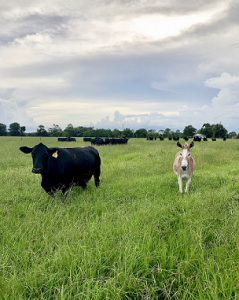If you drive around a few cattle ranches, you might find donkeys randomly thrown into a mix of cattle. Many people think of donkeys as cute and fun “yard ornaments”, but cattlemen can see donkeys as a method to predator management. In south/central Florida, coyotes have been an issue with catching and killing calves. Many ranchers have introduced donkeys into their herds for predator (coyote) protection.
Donkeys have very good eye sight and can see well at night, making them the perfect alarm system for a cattle operation. This is especially important when coyotes are in the area at night. Donkeys instinctively are weary of dog-like species so coyotes fall under that umbrella. When feeling threatened, a donkey will bray very loudly and attack with their teeth and hooves for protection.
Where are Coyotes?
Coyotes are found in all 67 counties in the state of Florida. They are typically elusive and shy but encounters with humans are occurring more frequently. Coyotes are usually as big as a medium sized dog (usually 2-37 inches from head to tail head) and about 20-50 pounds. Their coats are gray, white, tan, or brown. They help maintain a balanced ecosystem and controlling populations of rodents and smaller predators (foxes, rabbits, opossums, and raccoons). Their diet consists of more than just meat, including berries (fruit), and insects.
We recently had some local coyote trappers attend a cattlemen’s meeting to teach our producers more about coyote’s behavior and tendencies. Coyotes have territories that are larger than one typical pasture. Usually landscape fragmentation will set their boundaries (roadways, ditches, or fences). They usually don’t attack a calf unless they have ran out of small rodents in their territory to sustain their diet, or they have killed before and enjoyed the beef. The trappers recommended not eradicating coyotes in your area unless they have been catching and killing calves. Once an area is free of a coyote, a new one will take over that territory. If you aren’t having a problem with your current potential predator, the “new” coyote could present more of an issue. As the old saying goes, “If it ain’t broke don’t fix it!”
Would a Donkey fit your needs?
When thinking about adding a donkey to your operation, keep your number of donkeys to a minimum. Having more than one donkey in a location will cause them to buddy up and not protect the herd from predators.


(photo credit: Taylor Davis)
Meet Molly
If you’ve ever had a donkey you know they are very social creatures and take well to a herd of cattle. When I initially introduced my donkey, Molly, she did not take too well with our bull! They were trying to establish dominance on which one is “in charge” of the cows and calves. Over time they have become best friends and have the understanding they are both there to protect and watch over the other animals. It’s interesting to watch Molly in action when a new person enters the pasture or something doesn’t sit well with her. She finds the calves very quickly and starts circling them to ensure their safety.
Click here to learn more about coyotes from Florida Fish and Wildlife Conservation Commission of
 1
1
